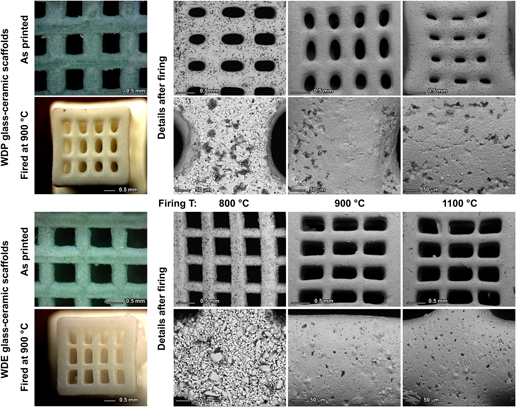Crossref Citations
This article has been cited by the following publications. This list is generated based on data provided by
Crossref.
Sayed, M.
Mahmoud, E.M.
Bondioli, F.
and
Naga, S.M.
2019.
Developing porous diopside/hydroxyapatite bio-composite scaffolds via a combination of freeze-drying and coating process.
Ceramics International,
Vol. 45,
Issue. 7,
p.
9025.
Thomas, Ashley
Johnson, Eldin
Agrawal, Ashish K.
and
Bera, Japes
2019.
Preparation and characterization of glass–ceramic reinforced alginate scaffolds for bone tissue engineering.
Journal of Materials Research,
Vol. 34,
Issue. 22,
p.
3798.
Ramírez, Jhon Alexander
Ospina, Valentina
Rozo, Angie A.
Viana, Maria I.
Ocampo, Sebastian
Restrepo, Sebastian
Vásquez, Neil A.
Paucar, Carlos
and
García, Claudia
2019.
Influence of geometry on cell proliferation of PLA and alumina scaffolds constructed by additive manufacturing.
Journal of Materials Research,
Vol. 34,
Issue. 22,
p.
3757.
Elsayed, Hamada
Rincon Romero, Acacio
Bellucci, Devis
Cannillo, Valeria
and
Bernardo, Enrico
2019.
Advanced Open-Celled Structures from Low-Temperature Sintering of a Crystallization-Resistant Bioactive Glass.
Materials,
Vol. 12,
Issue. 22,
p.
3653.
Elsayed, Hamada
Schmidt, Johanna
Bernardo, Enrico
and
Colombo, Paolo
2019.
Comparative Analysis of Wollastonite‐Diopside Glass‐Ceramic Structures Fabricated via Stereo‐Lithography.
Advanced Engineering Materials,
Vol. 21,
Issue. 6,
Varma, M. Vishnumaya
Kandasubramanian, Balasubramanian
and
Ibrahim, Sobhy M.
2020.
3D printed scaffolds for biomedical applications.
Materials Chemistry and Physics,
Vol. 255,
Issue. ,
p.
123642.
Yang, Li
2020.
Additive Manufacturing Processes.
p.
118.
Kang, Jin-Ho
Jang, Kyoung-Jun
Sakthiabirami, Kumaresan
Oh, Gye-Jeong
Jang, Jae-Gon
Park, Chan
Lim, Hyun-Pil
Yun, Kwi-Dug
and
Park, Sang-Won
2020.
Mechanical properties and optical evaluation of scaffolds produced from 45S5 bioactive glass suspensions via stereolithography.
Ceramics International,
Vol. 46,
Issue. 2,
p.
2481.
He, Chong
Cao, Yueqi
Ma, Cong
Liu, Xinger
Hou, Feng
Yan, Liwen
Guo, Anran
and
Liu, Jiachen
2021.
Digital light processing of complex-shaped 3D-zircon (ZrSiO4) ceramic components from a photocurable polysiloxane/ZrO2 slurry.
Ceramics International,
Vol. 47,
Issue. 23,
p.
32905.
Romero, Acacio Rincon
Elsayed, Hamada
Kraxner, Jozef
and
Bernardo, Enrico
2021.
Encyclopedia of Materials: Technical Ceramics and Glasses.
p.
728.
Paredes, Claudia
Martínez-Vázquez, Francisco J.
Elsayed, Hamada
Colombo, Paolo
Pajares, Antonia
and
Miranda, Pedro
2021.
Evaluation of direct light processing for the fabrication of bioactive ceramic scaffolds: Effect of pore/strut size on manufacturability and mechanical performance.
Journal of the European Ceramic Society,
Vol. 41,
Issue. 1,
p.
892.
Vasconcelos, João
Sardinha, Manuel
Vicente, Carlos M. S.
and
Reis, Luís
2022.
Additive Manufacturing of Glass-Ceramic Parts from Recycled Glass Using a Novel Selective Powder Deposition Process.
Applied Sciences,
Vol. 12,
Issue. 24,
p.
13022.
Daskalakis, Evangelos
Huang, Boyang
Vyas, Cian
Acar, Anil Ahmet
Fallah, Ali
Cooper, Glen
Weightman, Andrew
Koc, Bahattin
Blunn, Gordon
and
Bartolo, Paulo
2022.
Novel 3D Bioglass Scaffolds for Bone Tissue Regeneration.
Polymers,
Vol. 14,
Issue. 3,
p.
445.
SPIRRETT, Fiona
GOODRIDGE, Ruth
ASHCROFT, Ian
DATSIOU, Kyriaki
HOLCROFT, Chris
and
KIRIHARA, Soshu
2022.
Additive Manufacturing Processing of Glass Materials.
Journal of Smart Processing,
Vol. 11,
Issue. 4,
p.
163.
Xu, SongFeng
Zhang, Hang
Li, Xiang
Zhang, XinXin
Liu, HuanMei
Xiong, Yinze
Gao, RuiNing
and
Yu, ShengJi
2022.
Fabrication and biological evaluation of porous β-TCP bioceramics produced using digital light processing.
Proceedings of the Institution of Mechanical Engineers, Part H: Journal of Engineering in Medicine,
Vol. 236,
Issue. 2,
p.
286.
Kang, Jin-Ho
Sakthiabirami, Kumaresan
Jang, Kyoung-Jun
Jang, Jae-Gon
Oh, Gye-Jeong
Park, Chan
Fisher, John G.
and
Park, Sang-Won
2022.
Mechanical and biological evaluation of lattice structured hydroxyapatite scaffolds produced via stereolithography additive manufacturing.
Materials & Design,
Vol. 214,
Issue. ,
p.
110372.
Guo, Wang
Li, Bowen
Li, Ping
Zhao, Lei
You, Hui
and
Long, Yu
2023.
Review on vat photopolymerization additive manufacturing of bioactive ceramic bone scaffolds.
Journal of Materials Chemistry B,
Vol. 11,
Issue. 40,
p.
9572.
Bai, Jiaming
Sun, Jinxing
and
Binner, Jon
2023.
Additive Manufacturing.
p.
245.
Wang, Shuo
Peng, Lian
Song, Chengnan
and
Wang, Chengyu
2023.
Digital light processing additive manufacturing of thin dental porcelain veneers.
Journal of the European Ceramic Society,
Vol. 43,
Issue. 3,
p.
1161.
Zhang, Ning-Ze
Wang, Chao
Ran, Tian-Fei
Zeng, Fan-Chu
Wang, Min
Qin, Ling
and
Cheng, Cheng-Kung
2024.
Intervertebral osteointegration and biomechanical performance of bioactive lithium disilicate glass-ceramic scaffold fabricated by digital light processing.
Ceramics International,
Vol. 50,
Issue. 24,
p.
53674.



